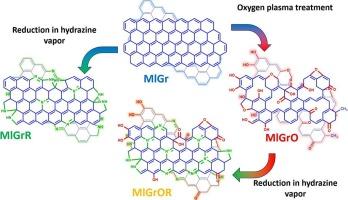Hydrazine nitridation of oxidized or non-oxidized twisted multilayer graphene
IF 5.1
3区 材料科学
Q2 MATERIALS SCIENCE, COATINGS & FILMS
引用次数: 0
Abstract
Twisted multilayer graphene films were synthesized using chemical vapor deposition. The films were treated in oxygen plasma and reduced with hydrazine in the vapor phase to replace inserted oxygen groups with nitrogen ones. Some of the films were treated by hydrazine without preliminary oxidation. The processes of graphene oxidation, reduction and nitridation were characterized using scanning electron microscopy and Raman spectroscopy. Changes in the chemical composition after nitriding of synthesized or oxidized graphene were determined using x-ray photoelectron spectroscopy (XPS). Electrical transport properties of the multilayer graphene films were measured using the Hall and magnetoresistive effect. It was found that pre-oxidation of the film before nitridization makes it possible to increase the amount of graphitized nitrogen, which is a strong donor impurity, by 1.5 times. This leads to a decrease in the concentration of positively charged carriers by more than two times and an increase in the film resistance by more than three times.

氧化或非氧化扭曲多层石墨烯的肼氮化
采用化学气相沉积法合成了多层扭曲石墨烯薄膜。膜在氧等离子体中处理,在气相中用肼还原,以氮基取代插入的氧基。部分膜经肼处理,未进行预氧化。利用扫描电镜和拉曼光谱对石墨烯氧化、还原和氮化过程进行了表征。利用x射线光电子能谱(XPS)测定了合成或氧化石墨烯氮化后化学成分的变化。利用霍尔效应和磁阻效应测量了多层石墨烯薄膜的电输运特性。研究发现,在氮化前对膜进行预氧化,可以使石墨化氮的含量增加1.5倍,而石墨化氮是一种强供体杂质。这导致正电荷载流子的浓度降低了两倍以上,薄膜电阻增加了三倍以上。
本文章由计算机程序翻译,如有差异,请以英文原文为准。
求助全文
约1分钟内获得全文
求助全文
来源期刊

Diamond and Related Materials
工程技术-材料科学:综合
CiteScore
6.00
自引率
14.60%
发文量
702
审稿时长
2.1 months
期刊介绍:
DRM is a leading international journal that publishes new fundamental and applied research on all forms of diamond, the integration of diamond with other advanced materials and development of technologies exploiting diamond. The synthesis, characterization and processing of single crystal diamond, polycrystalline films, nanodiamond powders and heterostructures with other advanced materials are encouraged topics for technical and review articles. In addition to diamond, the journal publishes manuscripts on the synthesis, characterization and application of other related materials including diamond-like carbons, carbon nanotubes, graphene, and boron and carbon nitrides. Articles are sought on the chemical functionalization of diamond and related materials as well as their use in electrochemistry, energy storage and conversion, chemical and biological sensing, imaging, thermal management, photonic and quantum applications, electron emission and electronic devices.
The International Conference on Diamond and Carbon Materials has evolved into the largest and most well attended forum in the field of diamond, providing a forum to showcase the latest results in the science and technology of diamond and other carbon materials such as carbon nanotubes, graphene, and diamond-like carbon. Run annually in association with Diamond and Related Materials the conference provides junior and established researchers the opportunity to exchange the latest results ranging from fundamental physical and chemical concepts to applied research focusing on the next generation carbon-based devices.
 求助内容:
求助内容: 应助结果提醒方式:
应助结果提醒方式:


